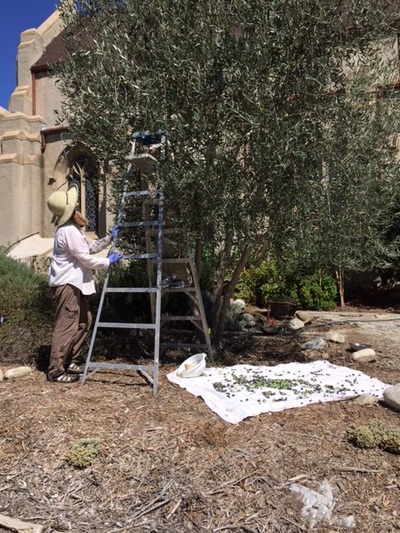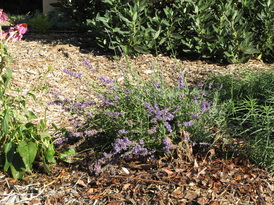Notes From the Garden
Throop Learning Garden experienced its first olive harvest. Our olive tree provided almost a bushel of olives, after several years with no harvest.
We watched the tree, in great anticipation, as olives began to form in August. We began to plan for an olive brining workshop in late October. We all were surprised when the olives came ripe the last week of August. Our surprise was burnished by gratitude at the bounty presented to us.
So we flew into action! Therese, Mimi, and Judith worked out a picking relay team-one on a ladder picking, one spotting the person on the ladder, and one gathering up the fallen olives onto a blanket placed under the tree. Much laughter ensued. And giant bowls brimming with olives.
But then the realization that we had an abundant harvest that needed to be processed. What should we do? None of us were very experienced with olive preserving.
We divvied the olives between 7 or 8 folks to try different processing methods and share what they learn at a future date. Michael is trying the Italian salt pack method suggested by the UC Davis ag department.Maggie is doing a salt brine.
Therese is trying a variant of the salt brine. I went with a Sicilian brine for the green olives and a Kalamata brine for the black, fully ripe olives.
Here are some good resources for olive processing and preserving:
UC-Davis—huge overview of many different techniques
http://anrcatalog.ucdavis.edu/pdf/8267.pdf
Brining olives
http://www.milkwood.net/2015/04/12/curing-olives-basic-brine-salt-methods/
Drying olives
http://www.markdymiotis.com/food/processing-olives/
http://www.motherearthnews.com/real-food/curing/how-to-cure-olives-zmaz76zhar.aspx
With perseverance and luck, we may be able to sample some finished olives at the next Repair Café at The Shed on October 10.
— January Nordman
Throop Learning Garden experienced its first olive harvest. Our olive tree provided almost a bushel of olives, after several years with no harvest.
We watched the tree, in great anticipation, as olives began to form in August. We began to plan for an olive brining workshop in late October. We all were surprised when the olives came ripe the last week of August. Our surprise was burnished by gratitude at the bounty presented to us.
So we flew into action! Therese, Mimi, and Judith worked out a picking relay team-one on a ladder picking, one spotting the person on the ladder, and one gathering up the fallen olives onto a blanket placed under the tree. Much laughter ensued. And giant bowls brimming with olives.
But then the realization that we had an abundant harvest that needed to be processed. What should we do? None of us were very experienced with olive preserving.
We divvied the olives between 7 or 8 folks to try different processing methods and share what they learn at a future date. Michael is trying the Italian salt pack method suggested by the UC Davis ag department.Maggie is doing a salt brine.
Therese is trying a variant of the salt brine. I went with a Sicilian brine for the green olives and a Kalamata brine for the black, fully ripe olives.
Here are some good resources for olive processing and preserving:
UC-Davis—huge overview of many different techniques
http://anrcatalog.ucdavis.edu/pdf/8267.pdf
Brining olives
http://www.milkwood.net/2015/04/12/curing-olives-basic-brine-salt-methods/
Drying olives
http://www.markdymiotis.com/food/processing-olives/
http://www.motherearthnews.com/real-food/curing/how-to-cure-olives-zmaz76zhar.aspx
With perseverance and luck, we may be able to sample some finished olives at the next Repair Café at The Shed on October 10.
— January Nordman











